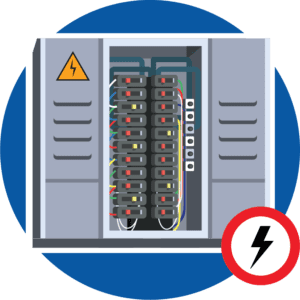5 Important Steps to Take After a Lightning Strike
Lightning strikes are a common occurrence, especially during the summer months when thunderstorms are more frequent. While most of us may not think much about it, a lightning strike can cause serious damage to our homes and properties if we’re not prepared.
In fact, according to the National Fire Protection Association, an estimated 22,600 fires were started by lightning strikes in 2018 alone. That’s why it’s important to know the necessary steps to take after a lightning strike occurs.
In this article, we’ll discuss the five important steps you should take after a strike to ensure your safety and protect your property.
Step 1: Check for injuries
After a lightning strike, it’s important to check for any injuries on yourself and those around you. Even if there are no visible signs of physical harm, lightning can cause internal damage that may not be immediately apparent. It’s crucial to seek medical attention as soon as possible, especially if someone has been directly struck by lightning.
Some common injuries from lightning include burns, nerve damage, and cardiac arrest. In severe cases, lightning strikes can even lead to death. That’s why it’s important to prioritize checking for injuries as the first step after a lightning strike.
If you or someone around you has been struck by lightning and is unconscious, it’s crucial to perform CPR until medical help arrives. Remember to always put your safety first and call for professional help if needed.
Lightning can also indirectly cause injuries, such as falls or accidents due to power outages. Be mindful of your surroundings and take extra caution, especially if you’re outside during a storm. It’s also important to note that children and pets may be more susceptible to lightning strike injuries. Keep them close and sheltered during a storm to ensure their safety.
Step 2: Inspect your property for damage
The second step is to inspect your property for any damage caused by lightning . While some damage may be visible, such as fires or structural damage, there could also be hidden damages that are not immediately apparent. This is where a professional lightning strike inspection comes in.
A professional inspection involves a thorough examination of your property, including the roof, electrical system, and other potential areas of damage. They can identify any structural issues that may have been caused by the lightning strike and assess the extent of damage to your electrical system. This information is essential for insurance claims and ensuring that all necessary repairs are made.
It’s also important to note that some insurance companies require a professional inspection after a strike to approve any claims for damages. By having a professional inspection done, you can ensure that your insurance claim is accurate and receive proper compensation for the damages.
Another reason why a professional inspection is important is for future safety. A lightning strike can weaken the structure of your home or property, making it more vulnerable to future strikes. A professional inspector can identify and address any potential hazards, ensuring the safety of you and your property.
Step 3: Unplug all electronic devices
As mentioned earlier, lightning can cause power surges in your home’s electrical system. These sudden spikes in voltage can damage or destroy any electronic devices that are plugged in at the time of the strike. This includes appliances such as refrigerators and televisions, as well as computers and other sensitive electronics.
To protect your devices, it’s important to unplug them from their power sources as soon as you can safely do so. This will not only prevent potential damage but also reduce the risk of fire caused by electrical malfunctions.
Remember to also unplug any outdoor equipment such as lawnmowers and pool pumps. These may have been affected by the strike and could pose a safety hazard if not properly disconnected.
In addition, it’s a good idea to turn off your circuit breaker until a professional electrician can inspect your home’s electrical system for any damage. This will help prevent further power surges and potential fires.
Step 4: Assess potential gas leaks
Lightning strikes can also cause gas leaks in homes with natural gas lines. If you smell gas or suspect a leak, evacuate the area immediately and call the gas company to report it. Do not turn on or off any switches, as this can create a spark and potentially cause an explosion.
It’s important to be aware of the signs of a gas leak after a lightning strike. These can include a strong odor of gas, hissing or roaring sounds near gas appliances, and dead or discolored vegetation near gas lines. If you notice any of these signs, follow the necessary precautions to ensure your safety and call for professional help.
In addition to being cautious around potential gas leaks after a lightning strike, it’s also important to regularly check your gas lines for any damage or wear. This can help prevent potential leaks and keep your home safe from the dangers of natural gas.
Step 5: Document the damage for insurance purposes
As mentioned earlier, it’s crucial to document the damage caused by a lightning strike for insurance purposes. This includes taking photos of any visible damage and making a list of affected items.
When filing an insurance claim, having this documentation will help support your case and potentially expedite the process. It’s also important to keep any receipts or invoices related to repairs or replacements needed due to the lightning strike.
Additionally, it’s a good idea to review your insurance policy to see what is covered in case of damage caused by a lightning strike. Some policies may have specific exclusions or requirements for coverage, so it’s important to be aware of these details.
In some cases, it may also be helpful to consult with a professional such as an electrician or home inspector to assess the extent of the damage and provide a detailed report for your insurance claim.
Conclusion
While lightning strikes may seem like a rare occurrence, they can cause significant damage to both our homes and our safety. By following these five important steps, you can ensure your well-being and minimize potential damage after a lightning strike. Remember to always prioritize safety and seek professional help if needed. Stay safe this summer!

